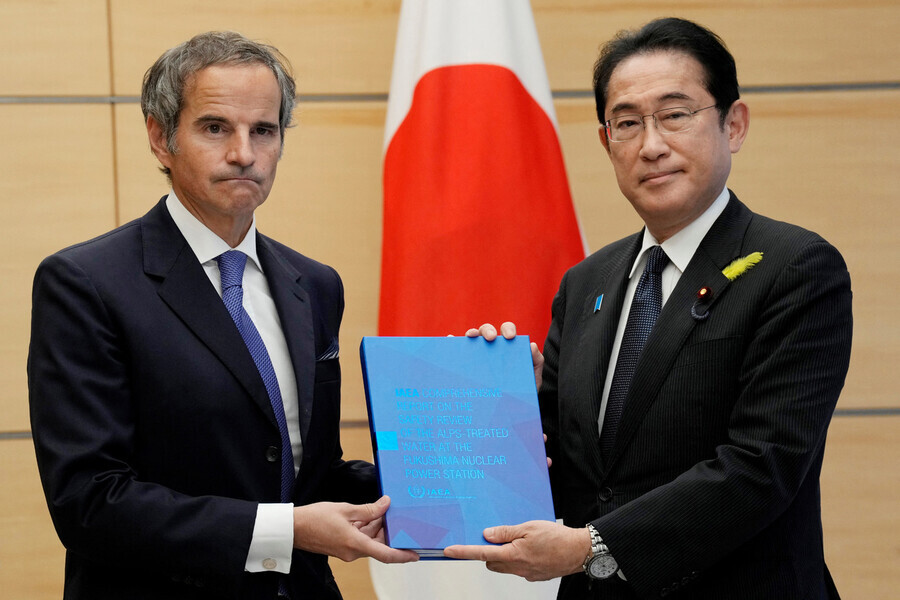hankyoreh
Links to other country sites 다른 나라 사이트 링크
IAEA gives Japan go-ahead to dump radioactive water into world’s oceans

The International Atomic Energy Agency (IAEA) has sided with the Japanese government’s position on the safety of discharging radioactive water from the Fukushima Daiichi nuclear power plant into the ocean, concluding that it is “consistent with relevant international safety standards” and “would have a negligible radiological impact on people and the environment.”
With the IAEA’s blessing, the Japanese government will begin releasing 1.33 million tons of treated water that is still contaminated with radionuclides into the ocean this summer, as part of a process that will last 30-40 years. But given the strong currents of distrust and opposition within both Japan and the international community, the issue isn’t likely to go away anytime soon.
On Tuesday afternoon, IAEA Director General Rafael Mariano Grossi visited the residence of Japanese Prime Minister Fumio Kishida in Tokyo to present the organization’s final report about the safety of releasing the contaminated water, called the “IAEA Comprehensive Report on the Safety Review of the ALPS-Treated Water at the Fukushima Daiichi Nuclear Power Station.”
“The approach and activities [related] to the discharge of ALPS treated water taken by Japan are consistent with relevant international safety standards,” the IAEA said in its 129-page report. “The controlled, gradual discharges of the treated water to the sea [. . .] would have a negligible radiological impact on people and the environment.”
After receiving the report, Kishida said, “As a responsible leader in the international community, I would never approve a discharge [of treated water] that would have a negative impact on the environment and the health of people in Japan and around the world.”
“People in Japan and elsewhere will be provided thorough explanations that are based in science and highly transparent,” he added.
The Japanese government asked the IAEA to review the safety of its plan to release the treated water after approving that plan in April 2021. The final report is based on six separate reports that the IAEA published between April 2022 and May 2023.
Considering that an interim report had earlier found no issues with the safety of the planned release, the final report was expected to reach the same conclusion. That prompted critics to say the report’s conclusion had been decided even before it was written.
In an apparent response to such criticism, Grossi said during a press conference at a press club in Tokyo that the IAEA would set up an office at the Fukushima nuclear plant to continue reviewing the discharge’s safety.
When asked about the purpose of visits to South Korea (July 7-9), New Zealand and the Cook Islands, all countries that have strongly opposed the discharge of treated water, Grossi spoke of the need for a comprehensive, neutral, objective and scientific assessment of the discharge and stressed that his responsibility is to respond to a variety of opinions.
The discharge of treated water can now begin as soon as Kishida gives the word.
The prime minister said during a meeting with leaders of the ruling Liberal Democratic Party on Tuesday morning that agencies across the Japanese government would cooperate to ensure safety, counteract losses caused by rumors, and provide helpful explanations and information both to people in Fukushima and to the international community.
Once the discharge of the contaminated water begins, observers will need to verify that the water was treated prior to release as planned, that relevant information is being provided transparently, and that the discharge’s impact on the human body and the ecosystem is being strictly monitored.
While the release of the IAEA report cleared away the final obstacle to Japan’s planned discharge of the water at Fukushima, the Korean government didn’t release a statement.
China’s Ministry of Foreign Affairs expressed its definite opposition to the discharge, stating that “The report cannot greenlight the discharge as it cannot prove that ocean discharge is the only option or the safest and most reliable option.”
By Kim So-youn, Tokyo correspondent
Please direct questions or comments to [english@hani.co.kr]

Editorial・opinion
![[Editorial] Intensifying US-China rivalry means Seoul must address uncertainty with Beijing sooner than later [Editorial] Intensifying US-China rivalry means Seoul must address uncertainty with Beijing sooner than later](https://flexible.img.hani.co.kr/flexible/normal/500/300/imgdb/original/2024/0517/8117159322045222.jpg) [Editorial] Intensifying US-China rivalry means Seoul must address uncertainty with Beijing sooner than later
[Editorial] Intensifying US-China rivalry means Seoul must address uncertainty with Beijing sooner than later![[Column] When ‘fairness’ means hate and violence [Column] When ‘fairness’ means hate and violence](https://flexible.img.hani.co.kr/flexible/normal/500/300/imgdb/original/2024/0516/7417158465908824.jpg) [Column] When ‘fairness’ means hate and violence
[Column] When ‘fairness’ means hate and violence- [Editorial] Yoon must stop abusing authority to shield himself from investigation
- [Column] US troop withdrawal from Korea could be the Acheson Line all over
- [Column] How to win back readers who’ve turned to YouTube for news
- [Column] Welcome to the president’s pity party
- [Editorial] Korea must respond firmly to Japan’s attempt to usurp Line
- [Editorial] Transfers of prosecutors investigating Korea’s first lady send chilling message
- [Column] Will Seoul’s ties with Moscow really recover on their own?
- [Column] Samsung’s ‘lost decade’ and Lee Jae-yong’s mismatched chopsticks
Most viewed articles
- 1[Editorial] Transfers of prosecutors investigating Korea’s first lady send chilling message
- 2[Exclusive] Unearthed memo suggests Gwangju Uprising missing may have been cremated
- 3S. Korea “monitoring developments” after report of secret Chinese police station in Seoul
- 4[Editorial] Intensifying US-China rivalry means Seoul must address uncertainty with Beijing sooner t
- 5Could Korea’s Naver lose control of Line to Japan?
- 6[Column] US troop withdrawal from Korea could be the Acheson Line all over
- 7Korea poised to overtake Taiwan as world’s No. 2 chip producer by 2032
- 8Korea cedes No. 1 spot in overall shipbuilding competitiveness to China
- 9Xi, Putin ‘oppose acts of military intimidation’ against N. Korea by US in joint statement
- 10Korea’s first openly trans athlete hopes to prompt a discussion by competing as herself